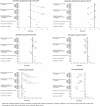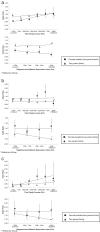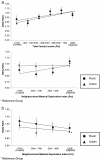Magnitude of income-related disparities in adverse perinatal outcomes
- PMID: 24589212
- PMCID: PMC3984719
- DOI: 10.1186/1471-2393-14-96
Magnitude of income-related disparities in adverse perinatal outcomes
Abstract
Background: To assess and compare multiple measurements of socioeconomic position (SEP) in order to determine the relationship with adverse perinatal outcomes across various contexts.
Methods: A birth registry, the Nova Scotia Atlee Perinatal Database, was confidentially linked to income tax and related information for the year in which delivery occurred. Multiple logistic regression was used to examine odds ratios between multiple indicators of SEP and multiple adverse perinatal outcomes in 117734 singleton births between 1988 and 2003. Models for after tax family income were also adjusted for neighborhood deprivation to gauge the relative magnitude of effects related to SEP at both levels. Effects of SEP were stratified by single- versus multiple-parent family composition, and by urban versus rural location of residence.
Results: The risk of small for gestational age and spontaneous preterm birth was higher across all the indicators of lower SEP, while risk for large for gestational age was lower across indicators of lower SEP. Higher risk of postneonatal death was demonstrated for several measures of lower SEP. Higher material deprivation in the neighborhood of residence was associated with increased risk for perinatal death, small for gestational age birth, and iatrogenic and spontaneous preterm birth. Family composition and urbanicity were shown to modify the association between income and some perinatal outcomes.
Conclusions: This study highlights the importance of understanding the definitions of SEP and the mechanisms that lead to the association between income and poor perinatal outcomes, and broadening the types of SEP measures used in some cases.
Figures



References
-
- Andrade CL, Szwarcwald CL, Gama SG, Leal Mdo C. Socioeconomic inequalities and low birth weight and perinatal mortality in Rio de Janeiro, Brazil. Cad Saude Publica. 2004;20(Suppl 1):S44–S51. - PubMed
-
- Hayward I, Malcoe LH, Cleathero LA, Janssen PA, Lanphear BP, Hayes MV, Mattman A, Pampalon R, Venners SA. Investigating maternal risk factors as potential targets of intervention to reduce socioeconomic inequality in small for gestational age: a population-based study. BMC Public Health. 2012;12:333. doi: 10.1186/1471-2458-12-333. - DOI - PMC - PubMed
-
- Messer LC, Vinikoor LC, Laraia BA, Kaufman JS, Eyster J, Holzman C, Culhane J, Elo I, Burke JG, O'Campo P. Socioeconomic domains and associations with preterm birth. Soc Sci Med. 2008;7:1247–1257. Social Science & Medicine, 2008. 7: p. 1247–1257. - PubMed
Publication types
MeSH terms
Grants and funding
LinkOut - more resources
Full Text Sources
Other Literature Sources
Medical

